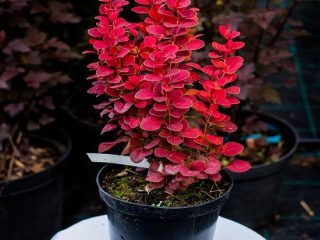Content
The gumi bush is an ornamental plant with numerous valuable properties. You can plant crops on your site both to decorate the garden and to obtain a harvest.
Origin story
The gumi bush is an exotic plant with a very ancient history. The exact origins of the perennial remain unknown, but some research suggests that the ancestors of the multifloral oleagin appeared on Earth as early as the Cretaceous period.
Central China is considered the birthplace of gumi. From this region the plant came to Japan, and in the 1920s it was brought to the south of Sakhalin. In the 1940s, a careful study of the perennial by Soviet botanists began. Currently, gumi is grown in the Moscow region and in the south of the country, in Bashkiria and Tatarstan, in Udmurtia and the Tomsk region.
Description and photo of the gumi plant
Gumi, or multi-flowered oleaster (Elaegnus multiflora) is a shrub of the Elaegnus multiflora family. It has a highly branched surface root system, capable of extending 1.5 m beyond the crown. The shoots of the oleaster are thin, with small spines, the leaves are elliptical with a solid edge.
Gumi is characterized by slow growth in the first two years of life. Subsequently, it begins to add 50-80 cm per season. It usually bears fruit for the first time in the third year after planting. It is capable of producing crops for 20-25 years, and the performance is quite good, up to 15 kg per bush.
Gumi is a heat-loving plant and does not tolerate frost. With the onset of autumn in the middle zone, it must be carefully covered for the winter. When growing multi-flowered oleaster, you need to make sure that the shrub receives enough light. In shaded places, gumi develops reluctantly and often stops bearing fruit.

The gumi bush grows up to 1.5-2 m above the ground
Gumi flowering
The gumi bush begins to bloom in April or May. The buds of the plant are small, white or light yellow, collected in small clusters of three. Flowers are attached to the shoots on short stalks.
Gumi blooms with bisexual buds and does not require pollinators for the formation of the ovary. During the flowering period, the shrub emits a strong, pleasant aroma.
Useful properties of the gumi plant
The multi-flowered oleaster is valued not only for its decorative properties. The shrub has numerous beneficial qualities. The fruits of the oleaster multiflorum contain a huge amount of vitamins and minerals, namely:
- ascorbic acid;
- potassium and calcium;
- flavonoids;
- essential oils;
- phosphorus and zinc;
- carotene;
- copper and sulfur;
- amino acids lysine, aspargine and proline;
- antioxidants.
When used correctly, gumi has a very beneficial effect on the human body. Based on the fruits of the plant, infusions and decoctions are prepared, as well as strong alcohol extracts. Medicines from the berries of the multifloral oleaster:
- improve metabolic and digestive processes;
- help reduce cholesterol levels;
- have a beneficial effect on brain activity;
- regulate water-salt balance in tissues;
- increase life expectancy;
- stimulate hair and nail growth;
- promote the removal of parasites from the intestines;
- provide tuberculosis prevention;
- improve the condition of arthritis and rheumatism.
Products based on greens and fruits of the gumi bush are useful for skin damage. Infusions are used externally to treat wounds and burns. The fruits and leaves of the plant have pronounced anti-inflammatory properties. They can also be used as a rinse for rheumatism and sore throat.
Gumi berry flavor
At the end of June or at the beginning of July, the multi-flowered oleaster sets fruits - oblong-oval berries up to 2 cm in length on thin stalks. The skin starts out green but turns yellow as it ripens and eventually turns red. Ripe berries stay on the branches of the bush for a long time and do not fall to the ground for two months or more. Often the fruits continue to stay on the shoots until winter, although they dry out and become noticeably wrinkled. The ripening period takes about 17 days.
The berries of the multifloral oleaster are edible, have a sour taste and resemble black currants. At the very beginning of ripening, the pulp has tart and astringent notes, then becomes more tender and pleasant. The fruits are not suitable for transportation - their skin is very thin and easily damaged.
Application
Vitamin-rich gumi berries, once fully ripe, are often consumed as a refreshing dessert. The fruits can be eaten in small quantities shortly before the main meal or in between meals. Gumi will improve appetite and speed up digestion processes, and will prevent constipation and diarrhea.
The berries of the multifloral oleaster are also used for making juice, compote and jam. With minimal heat treatment, the fruits retain a maximum of vitamins, organic acids and pectins.
Gumi varieties
Photos of gumi bushes show that the perennial comes in many varieties. There are several popular varieties.
Crillon
The variety was bred on Sakhalin and is characterized by frost resistance and high immunity to fungi. The shrub bears bright scarlet berries with a sweet taste. The harvest ripens quite late, and the pulp contains a particularly high amount of vitamin C.

The berries of the multi-flowered oleaster variety Crillon lack a characteristic aroma
Taisa
The gumi variety for the Moscow region is compact - the straight branches of the bush weakly spread to the sides. The leaves of the multi-flowered oleaster are small, hard, rich green with a glossy surface. The harvest ripens early, with berries weighing up to 1.2 g appearing on the shoots.

Gumi variety Taisa has a sweet and sour taste
Sakhalin first
The perennial of this variety has a spherical outline, the branches of the bush are brownish-red, with thin thorns at the bottom. The plant blooms with pale pink flowers and emits a pleasant aroma. The berries of the variety are red speckled, weigh up to 1.5 g, and have a pleasant sweet taste with sourness.

The Sakhalinsky first variety can withstand frosts down to -30 °C and easily recovers after freezing
Kunashir
A tall shrub with straight greenish shoots and sparse thorns has large shiny leaves. It blooms with white-cream buds and bears bright red fruits in the fall. The taste of the berries is sweet, the sourness in it is almost invisible.

Gumi Kunashir bears quite large fruits - up to 2.5 g by weight
Planting gumi in spring in open ground
To grow a gumi plant on a site, you need to choose a fertile, well-lit place, sheltered from strong winds. Loams and sandstones that are neutral in composition are best suited for shrubs.
The rules for planting gumi suggest using the following algorithm:
- A hole up to 50 cm deep is prepared on the site.
- A drainage layer of crushed stone or sand is poured into the bottom of the pit.
- Fill the hole up to half with a nutrient substrate with the addition of humus and mineral fertilizers.
- Place the seedling in the center of the hole.
- Sprinkle the roots with soil and lightly compact the soil.
- Water the plant abundantly.
When planting, you need to deepen the gumi by 8-10 cm.
Gumi bush care
The gumi garden plant does not require complex care after planting. You need to pay attention to several points:
- Watering. After planting, multi-flowered oleaster requires moisture only during periods of severe drought. As moisture evaporates from the soil, 3-4 buckets of water should be added to the root of the bush. After this, the soil must be carefully loosened.
- Feeding. For abundant fruiting, it is necessary to fertilize gumi 4-5 times during the season. In spring and early summer, mullein infusion is used; closer to autumn, attention is paid to potassium and phosphorus fertilizing.
- Trimming.Once every three years, old branches that no longer take part in fruiting need to be removed from the shrub. In spring, it is recommended to trim the tops of the shoots by 2-3 cm to stimulate growth. In the autumn, sanitary pruning is carried out for gumi and broken and diseased branches are removed.
Before winter, the bush must be bent to the ground, secured and wrapped in agrofibre. The root area of the multi-flowered oleaster is covered with a thick layer of peat or pine needles.
Reproduction of gumi
You can propagate gumi on a site in two vegetative ways:
- Cuttings. At the beginning of summer, a shoot about 10 cm long should be cut off from a green branch of the bush and treated with a growth stimulator. Then the cuttings are planted in damp sand, covered with film and left in a well-lit place. After the shoot produces new leaves, it can be transplanted into open ground.
- Layerings. The lower branch of the bush is bent to the ground, sprinkled with soil in the middle part and secured with wire. Throughout the season, the cuttings are watered and fertilized, and the following summer they are separated from the mother plant.
If desired, in October you can sow fresh seeds of multi-flowered oleaster into the soil. But their germination rate is low, so this method is rarely used.

When propagated by cuttings, gumi takes root in about two months.
Pests and diseases
If not cared for properly, the gumi fruit bush can suffer from diseases and pests. The threat to him is:
- coccomycosis - reddish spots appear on the leaves, over time necrotic areas and holes form on the plates;
Coccomycosis develops with high humidity in cool weather
- klyasterosporiosis - the greenery of the plant becomes covered with brown marks with a crimson edge, the gum quickly dries out;
Clusterosporiasis affects shrubs at temperatures of about 25 ° C during the rainy season
- aphids - a pest that sticks to the leaves of a young plant, sucks the juices out of them and leads to deformation of the plates.
Aphids often become carriers of viral and fungal diseases
- For diseases, multi-flowered oleaster is sprayed with copper sulfate and the drug Fitosporin. Infusion of onion peels, soap solution and industrial insecticides are good against pests.
Possible problems during cultivation
Growing gumi berry bushes is not always possible without problems. Gardeners usually face two difficulties.
Why doesn't gumi bloom?
Both fruit and ornamental gumi varieties begin to bloom 2-3 seasons after planting. If no buds appear, this may be caused by:
- lack of sunlight;
- low nutrient content in the soil;
- moisture deficiency.
Regular watering and feeding the bushes with potassium and phosphorus help eliminate the problem. If the multi-flowered oleaster is growing in an unsuitable area, it should be replanted.
Why does gumi bloom but not bear fruit?
For the first time, the shrub produces a harvest in 4-5 years of life. If the gumi blooms but does not set berries, most likely it is still too young to bear fruit.
An adult perennial may not produce a crop if the variety is self-sterile. In this case, next to the shrub you need to plant several more specimens of multi-flowered oleaster at a distance of 2-3 meters.
Conclusion
The gumi bush has a high decorative value and produces healthy edible berries. When growing a perennial, you need to pay attention to fertilizing and winter insulation.
Reviews from gardeners about Eleven multiflorum











